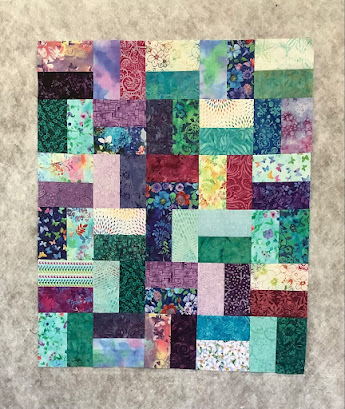It’s early August and two-thirds of the year is in the record book. My Create Daily Tracker is progressing nicely and I’ve also happily fulfilled 7 of 9 Make Nine 2023 prompts.
 |
| Create Daily Tracker, August 2023 |
The blue boxes in the Create Daily Tracker document my two 100 Day Projects this year. Both projects—100 Days of Hand Lettering and 100 Days of Textile and Stitch Collage—provided growth in my art and stitching skills. The other colorful boxes on the tracker represent creative activities such as slow stitching, patchwork, knitting, garment sewing, and free-motion quilting.
 |
| Make Nine 2023 tracker, August 2023. |
Watercolor and Slow Drawing
I participated in an online Challenge last month called "World Watercolor Month" and occasionally marry watercolor painting with slow drawing. The lime green colored squares on the Create Daily Tracker reflect these art practices. This online Challenge was also a Make Nine project for me.
 |
| Slow drawing on watercolor. |
Knitting dishcloths with a slip stitch pattern
Recently, I’ve picked up my knitting needles and cotton yarn to make hand knit dish cloths (the lavender colored boxes). These are easy, mindful, and portable projects. I have the slip stitch pattern memorized and this is a convenient project on which to put in a few rows at the end of a day.
 |
| Knitting dishcloths with slip stitch pattern. |
Improvisational patchwork: triangles
After finishing 12 kitty quilts—which are always improvisationally pieced with scraps and discontinued fabric samples—I pulled out a 2012 UFO [unfinished object] and am doing experimentation with improvisational patchwork. I'm starting with improv triangles. Patchwork is represented by the orange colored boxes in the Tracker.
 |
| Improv triangles. |
Mindless patchwork and charity quilts
The design wall is always full of work in-progress... quilt layouts, test blocks, PFDs (projects half done). I did purge some scraps for a charity cuddle quilt for my guild. Sewing rectangle blocks is relaxing and good mindless patchwork.
 |
| Design wall with various in-progress work. |
It's also a good feeling to achieve a "finish" now and then, even if it's from a less time-consuming project.
 |
| Finished cuddle quilt top. |
Organizing the scrap pile
I gathered together the piles of half-square triangles [HSTs] created from leaders and enders and now have them in a box. These HSTs are made from the diagonal joins on scrappy bindings and "daughter blocks" from making flying geese and other flippy-corner units.
 |
| Scrappy half-square triangles. |
It's fun to do these in batches: press a bunch, then clip the dog ears and square up a bunch.
 |
| Storage box for triangle scraps and finished HSTs. |
Don't know yet what these HSTs will ultimately become. For now, they're all in a box. Any ideas on what to make with multi-size, scrappy half-square triangles?






























